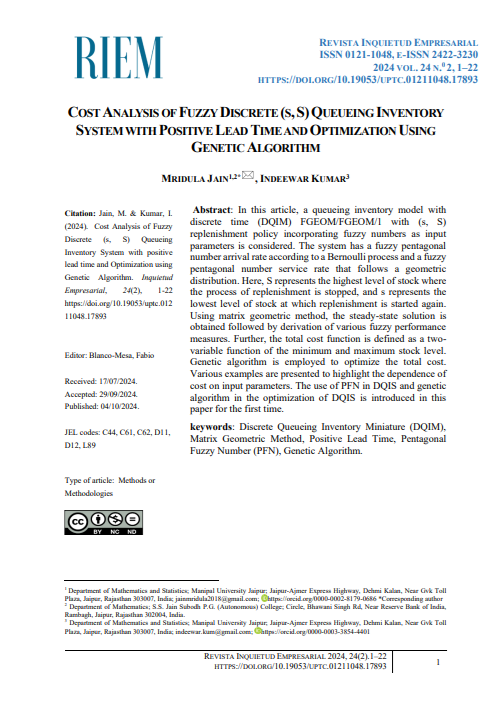Cost Analysis of Fuzzy Discrete (s, S) Queueing Inventory System with Positive Lead Time and Optimization using Genetic Algorithm

Abstract
In this article, a queueing inventory model with discrete time (DQIM) FGEOM/FGEOM/1 with (s, S) replenishment policy incorporating fuzzy numbers as input parameters is considered. The system has a fuzzy pentagonal number arrival rate according to a Bernoulli process and a fuzzy pentagonal number service rate that follows a geometric distribution. Here, S represents the highest level of stock where the process of replenishment is stopped, and s represents the lowest level of stock at which replenishment is started again. Using matrix geometric method, the steady-state solution is obtained followed by derivation of various fuzzy performance measures. Further, the total cost function is defined as a two-variable function of the minimum and maximum stock level. Genetic algorithm is employed to optimize the total cost. Various examples are presented to highlight the dependence of cost on input parameters. The use of PFN in DQIS and genetic algorithm in the optimization of DQIS is introduced in this paper for the first time.
JEL Codes: C44, C61, C62, D11, D12, L89
Received: 17/07/2024. Accepted: 29/09/2024. Published: 04/10/24.
Keywords
Discrete Queueing inventory model, Matrix geometric method, Pentagonal fuzzy number, Genetic algorithm
References
- Abdali, N., Heidari, S., Alipour-Vaezi, M., Jolai, F., & Aghsami, A. (2024). A priority queueing-inventory approach for inventory management in multi-channel service retailing using machine learning algorithms. Kybernetes. https://doi.org/10.1108/K-07-2023-1281 DOI: https://doi.org/10.1108/K-07-2023-1281
- Akar, N., & Dogan, O. (2021). Discrete-time queueing model of age of information with multiple information sources. IEEE Internet of Things Journal, 8(19), 14531–14542. https://doi.org/10.1109/JIOT.2021.3053768 DOI: https://doi.org/10.1109/JIOT.2021.3053768
- Anilkumar, M. P., & Jose, K. P. (2022). Analysis is a discrete time queueing-inventory model with back-order of items. 3C Empresa. Investigación y Pensamiento Crítico, 11(02), 50–62. https://doi.org/10.17993/3cemp.2022.110250.50-62 DOI: https://doi.org/10.17993/3cemp.2022.110250.50-62
- Atencia, I. (2015). A discrete-time queueing system with server breakdowns and changes in the repair times. Annals of Operations Research, 235(1), 37–49. https://doi.org/10.1007/s10479-015-1940-3 DOI: https://doi.org/10.1007/s10479-015-1940-3
- Atencia, I. (2017). A Geo/G/1 retrial queueing system with priority services. European Journal of Operational Research, 256(1), 178–186. https://doi.org/10.1016/j.ejor.2016.07.011 DOI: https://doi.org/10.1016/j.ejor.2016.07.011
- Balagopal, N., Deepthy, C., Jayaprasad, P., & Varghese, J. (2021). Comparison of discrete time inventory systems with positive service time and lead time. Korean Journal of Mathematics, 29(2), 371–386. https://doi.org/10.11568/KJM.2021.29.2.371
- Balagopal, N., Deepthy, C., Jayaprasad, P., & Varghese, J. (2020). Discrete time queueing inventory models with inventory dependent customer arrival under (s; s). Neural, Parallel, & Scientific Computations, 28(1), 13-26. https://doi.org/10.46719/npsc20202813 DOI: https://doi.org/10.46719/npsc20202813
- Jeganathan, K., Harikrishnan, T., Lakshmi, K. P., & Nagarajan, D. (2023). A multi-server retrial queueing-inventory system with asynchronous multiple vacations. Decision. Analytics Journal, 9, 100333. https://doi.org/10.1016/j.dajour.2023.100333 DOI: https://doi.org/10.1016/j.dajour.2023.100333
- Jain, M., & Jain, A. (2021). Computing and analysis of multi-server queueing model using pentagonal fuzzy numbers. IOP Conference Series: Materials Science and Engineering, 1099(1), 012006. https://doi.org/10.1088/1757-899X/1099/1/012006 DOI: https://doi.org/10.1088/1757-899X/1099/1/012006
- Jain, M., & Jain, A. (2022). Genetic algorithm in retrial queueing system with server breakdown and caller intolerance with voluntary service. International Journal of System Assurance Engineering and Management, 13(2), 582–598. https://doi.org/10.1007/s13198-021-01364-9 DOI: https://doi.org/10.1007/s13198-021-01364-9
- Ke, J.-B., Ke, J.-C., & Lin, C.-H. (2010). Cost optimization of an M/M/r queueing system with queue-dependent servers: Genetic algorithm. In: QTNA '10: Proceedings of the 5th International Conference on Queueing Theory and Network Applications (pp. 82–86). https://doi.org/10.1145/1837856.1837869 DOI: https://doi.org/10.1145/1837856.1837869
- Kempa, W. M., & Paprocka, I. (2024). A Discrete-Time Queueing Model of a Bottleneck with an Energy-Saving Mechanism Based on Setup and Shutdown Times. Symmetry, 16(1), 63. https://doi.org/10.3390/sym16010063 DOI: https://doi.org/10.3390/sym16010063
- Krishnamoorthy, A., Chakravarthy, S. R., Melikov, A., & Narayanan, V. C. (2024). Queueing-inventory: Analytical and simulation modeling and classical and retrial queues and inventory. Annals of Operations Research, 340(2–3), 1221–1224. https://doi.org/10.1007/s10479-024-06015-3 DOI: https://doi.org/10.1007/s10479-024-06015-3
- Lan, S., & Tang, Y. (2017). Performance analysis of a discrete-time queue with working breakdowns and searching for the optimum service rate in working breakdown period. Journal of Systems Science and Information, 5(2), 176–192. https://doi.org/10.21078/JSSI-2017-176-17 DOI: https://doi.org/10.21078/JSSI-2017-176-17
- Narayanamoorthy, S., & Ramya, L. (2017). Multi server fuzzy queuing model using DSW algorithm with hexagonal fuzzy number. International Journal of Pure and Applied Mathematics, 117(11), 385-392.
- Visalakshi, V., & Suvitha, V. (2018). Performance measure of fuzzy queue using pentagonal fuzzy numbers. Journal of Physics: Conference Series, 1000, 012015. https://doi.org/10.1088/1742-6596/1000/1/012015 DOI: https://doi.org/10.1088/1742-6596/1000/1/012015
- Xu, Y., Li, K., Hu, J., & Li, K. (2014). A genetic algorithm for task scheduling on heterogeneous computing systems using multiple priority queues. Information Sciences, 270, 255–287. https://doi.org/10.1016/j.ins.2014.02.122 DOI: https://doi.org/10.1016/j.ins.2014.02.122
- Zhou, S., Liu, L., & Li, J. (2015). A discrete-time queue with preferred customers and partial buffer sharing. Mathematical Problems in Engineering, 2015, 1–12. https://doi.org/10.1155/2015/173938 DOI: https://doi.org/10.1155/2015/173938
